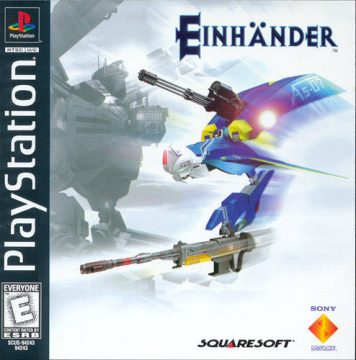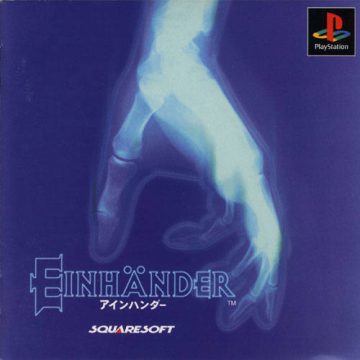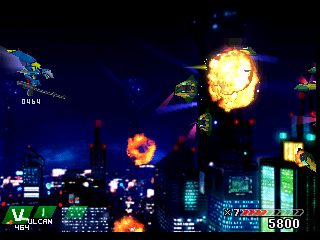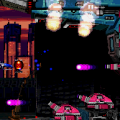After their merger with the Enix Corporation in 2003, RPG developer/publisher Squaresoft’s modus operandi seems set on milking their hit Final Fantasy franchise for all its worth, resulting in store shelves being assaulted by numerous sequels, spinoffs, and remakes from the series. Earlier though, in addition to their RPG offerings, Square stressed to diversify their portfolio by exploring outside genres of gaming. Though most of games that resulted from this initiative were published by Square and developed by other software houses, Square themselves developed perhaps the oddest departure from their traditional fare. Hot off the heels of the insanely successful Final Fantasy VII, in late 1997, Square introduced Einhänder (German for “One-hander”, referring to a sword), a horizontally scrolling shooter for the Sony PlayStation. Contrary to what one would believe about such a staunch RPG maker creating a shmup, which are two genres that are nearly polar opposites of each other in design and objective, Einhänder managed to turn out quite well.
Likely due to Square channeling the storytelling skills honed from years of RPG development, Einhänder‘s plot is rather fleshed out in comparison to the shallower “(Insert hostile force) is attacking whatever peaceful nation, so pilot your specially designed (insert ship name) fighter to destroy them all by yourself.” style stories all too common in the shooting game genre. The setting is in the distant future, where several humans have since separated from the Earth and have taken up residence on the Moon. This new nation, Selene, was threatened by those that remained on Earth, which eventually led to a war between the two sides. This “First Moon War” resulted in devastating casualties on both sides, and the destruction of most of Earth’s surface due to bombing. At the end of the war, Selene went silent and what remained of Earth joined to become a totalitarian, militaristic, society; of which German became the common language among all citizens.
Years later, Selene reemerges to antagonize Earth for their natural resources, resulting in a second Moon War. This time, as the battle between the two factions eventually stalemated, Selene developed the “Einhänder” program to regain their early upper hand. This program’s objective is to send one man groups of specially trained pilots in their advanced fighters on Kamikaze style missions to cause as much damage on Earth as possible before being shot down. The game puts you in the role of an Einhänder pilot, about to begin an attack run on Earth starting with the Earth’s capital city.
The distinct feature of the Einhänder ships and the source of the name given to them comes from the single, robotic, manipulator arms attached directly under their bodies. Using these claw-like arms, the Einhänder can steal specific types of weapons used by the enemy, referred to as “Gunpods”, and enhance their relatively modest initial weaponry. However, the catch to this is that the gunpods have finite ammo, which makes the game a constant struggle to replace and/or replenish gunpods while fighting off the masses of enemy reinforcements.
The are three variations of the Einhänder ships available for you to pilot:
Ships
Endymion FRS Mk. II
This is the game’s common fighter. Equipped with a default machine gun, it can grab up to three gunpods and actively use one, switching between them as necessary. It also receives less ammo from gunpod pickups than the other two, since it’s easy to stockpile ammo for gunpods not in use.
Endymion FRS Mk. III
This craft is best suited for beginners. It only allows you to carry and use one gunpod at a time, but it has an extra default machine gun for added power.
Astraea FGA Mk. I
Astraea allows you to use two gunpods at once, with them occupying the both top and bottom of the craft respectively. It has a default machine gun that is overridden when two gunpods are being used, and unlike the other two, a gunpod in the top position always fires directly forward (sans the vertically firing Hedgehog gunpod), as some gunpods will fire on an upwards angle with the other craft. A difficult craft to use since managing and juggling two gunpods simultaneously in the heat of battle can be distracting, but the right combination of gunpods can make it powerful and versatile.
There are also two unlockable ships, one being the “Schabe” (Cockroach in English) small police hovercraft that are the common enemies in the first stage, unlocked by collecting at least 15 S.Bonuses (what those are will be explained below) during a single playthrough. It operates like a traditional shoot-em-up ship, powering up its single weapon by collecting gunpods. The other is the special “Selene” fighter which looks and operates exactly like the Astraea with the exception of receiving 9999 ammo upon the collection of each gunpod. It is awarded to you by completing the game on hard using no more than three continues.
As for the gunpods, there are eight regular ones that appear commonly throughout the game and four secret ones that only appear after fulfilling specific requirements. At the beginning of the game, you can choose any one of the weapons that you’ve found in previous play throughts, which will be equipped by default whenever you resurrect. Hence, when you discover one of the secret weapons, you can start with it next time you play. These weapons range between more conventional types, such as the Vulcan machine gun and the grenade launcher, and more elaborate weaponry such as Blade, a giant lightsaber style energy sword that you can actually swing with the manipulator arm (sans with the Astraea) and Riot, which dismantles enemies from the inside via electric discharge. Some gunpods function differently depending on what position there in. The Wasp gunpod for example fires stronger dumbfire rockets on the bottom of the Einhander and weaker homing missiles on top. In addition to their offensive capabilities, gunpods can function as pseudo-defensive mechanisms and can absorb enemy fire. If they take too much damage however, they will eventually be destroyed. The gunpods’ damage level is indicated by color at the bottom of the screen along with their remaining ammunition.
For the PS1, the graphics in Einhänder are very impressive, featuring ships and backgrounds rendered fully in 3D. Even today, the graphics have aged well when compared to other scrolling shooters of the era that attempted the same thing. Though the camera mostly stays in the normal 2D side scrolling perspective, every now and then, primarily during dramatic cut-scenes and boss fights, the camera will pan around your ship at different angles, giving off a cool pseudo-3D effect for the play area (your ship still moves on an X-Y axis regardless). This is similar to the early PS1 shooter Philosoma, although Einhänder handles it much better.
The gameplay is likened to a traditional methodical style shooter, most similarly to the design of the R-Type series. The game moves at a relatively slow pace and places emphasis on the memorization of enemy patterns and attacks and on avoiding obstacles and scenery. Effectively and strategically using the gunpods is an equally important success factor, as being caught with the wrong types gunpods for the situation will often lead to a quick death. Whenever your ship finds itself stuck without any gunpods, you can use its manipulator arm to attack and defect small bullets as a last resort, but the arm functions poorly at both of these capabilities. Getting killed will send you back to a checkpoint, again similar to R-Type. You have only ten continues to make it to the end of the game.
The scoring system rewards you for both killing enemies rapidly and killing multiple enemies at once. A meter located at the bottom corner of the screen keeps track of a scoring multiplier, and as you kill enemies, this meter will fill up, increasing the multiplier from 1x to 16x. The amount points you get for destroying an enemy will effectively be multiplied by whatever is indicated on the meter. If you stall at killing things, the meter will gradually decrease until it reverts back to 1x; the higher the multiplier, the faster it will decrease. Once the meter passes 16X, the meter will flash red and give you a steady stream of bonus points for an extended period of time. Also, in every stage, you can collect up to three S.Bonuses by fulfilling specific requirements such as destroying all the neon building signs in the first stage. Collecting all of the S.Bonuses awards you extra points and some will allow you to travel through new area of the stage, which greatly enhances the replay value. You can earn extra points at the end of each stage based on the number of enemies shot down, the number of gunpods collected, the time it took to defeat the boss, and the number of lives left.
Backed by its solid gameplay, Einhänder excels in style and presentation. The locations traveled through on Earth represent two extremes, from the Blade Runner inspired capital megacity and the many state of the art, well armed factories and supply depots built by the Empire, to the desolate ruins and wastelands that serve as reminders of Earth’s lingering devastation. During all this, the game makes an admirable attempt to keep you immersed in the story. FMV and pilot narration sequences are scattered throughout the game’s pivotal moments, and in between stages, you receive messages from your superiors briefing you on your next target during end of stage score calculations. In the game’s climatic moment, you receive an order to take down an enemy shuttle headed for the moon within a two minute time limit. Your performance in this operation leads to two outcomes, where failure results in an automatic bad ending, and success continues the game further, introducing an unexpected yet welcome plot twist. Upon completing your objective, you’re hunted down by Hyperion and decide to rebel against them, the final stage consisting of a head-spinningly awesome final battle in outer space against your former commanders.
Without a doubt, one of the most noteworthy features of Einhänder is its bosses, which are some of the most lively and animated ones seen in any shooter. Just about all are cool looking, and some are especially crazy, like the “Salamander” submarine midboss that grows arms and swings around on ceiling pipes like monkey bars, and the “Ausf De Gestell” midboss patterned after a crazed gorilla. It introduces itself by beating its chest and then frantically flips around the screen, trying is hardest to wildly swipe you down, slam you into the ground, and throw boxes at you Donkey Kong-style among a myriad of other attacks. To put icing on the cake, when each boss initially appears, they taunt you with badass sounding German before attacking.
Einhänder‘s soundtrack is composed by Kenichiro Fukui, who previously worked for Konami before joining up with Square, being involved with Sunset Riders, Violent Storm, and Lethal Enforcers among other games. His latest exploits at Square include his contributions to the soundtracks of Front Mission 5, Final Fantasy XII: Reverent Wings, and Project Sylpheed, along with his involvement with the Final Fantasy related rock band The Black Mages. The music is best described as dance oriented techno, and all of it is great techno at that. The are several tracks that lean towards a slower, more atmospheric feel, such as the beginning of Stage 3’s “Silence”, but the majority of music is thumping and bombastic, but never annoyingly so, which is a trap techno music often falls into. An interesting aspect of the soundtrack is that Fukui sometimes likes to sample other genres of music and fuse them with the game’s existing techno sound. One of the boss themes: “Shudder” for example, suddenly busts out into a semi-decipherable rap. Another boss theme, “Thermosphere”, has its main melody lead by piano, which is backed by an accompanying techno beats. The first stage begins with your ship flying through city, set to the sound of a female opera singer, backed by a short, sinister theme.
Although today, Einhänder is fairly uncommon, its price tends to be significantly cheaper than the norm of what hard to find shooters typically demand on the aftermarket. Thankfully, this makes Einhänder more accessible to someone other than zealous collectors and/or fanatics of the genre, and it is worth it to experience one of Square’s finest non-RPG efforts. It’s especially remarkable considering it’s one of the few shooters for the PS1 that was actually released in America.
Between the Japanese and North American versions of Einhänder, gameplay wise, the Einhänder‘s arm switches faster in the American version (sans with the Astraea, where it is the same speed in both versions), and for some of the gunpods, you get different amounts of ammo from pickups in the Japanese version then you do in the American. As far game extras, the Galleries in each version has pictures exclusive to each other, but the Japanese gallery is crappier to navigate through. Exclusive to the Japanese version is a “Free” mode, that is awarded to you when complete the game while getting all 21 S.Bonuses. Free mode gives you a stage select option and allows you to play the game with unlimited continues. Finally, there are various text alterations in the menus and narrations of both versions, ‘Continue’ and ‘Quit’ in the American version become ‘Exit’ and ‘Title’ in the Japanese for example. The “Great War” in the American version is actually known as “World War III” in the Japanese version.
Links:
GameFAQs Very comprehensive FAQ about Einhänder.
GameFAQs Detailed plot analysis FAQ for Einhänder.
Encyclopedia Mythica A quick source for mythology refecences.
Theoi Greek Mythology A more detailed mythology source.
Sodom and Gomorrah – Wikipedia A good non-biased enough analysis of it.




